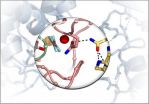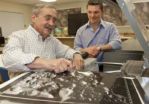(Press-News.org) Beating the flu is already tough, but it has become even harder in recent years – the influenza A virus has mutated so that two antiviral drugs don't slow it down anymore.
Reporting their findings in the journal Science, researchers from Florida State and Brigham Young move closer to understanding why not, and how future treatments can defeat the nasty bug no matter how it changes.
The two drugs, amantadine and rimantadine, are no longer recommended by the CDC for use against flu.
They used to work by blocking a hole in the influenza A virus called the "M2 channel," which plays a key role in the virus's ability to reproduce. When the channel changed ever so slightly at the atomic level, the virus became resistant to the drugs.
The research team used a 16-ton magnet to give the virus what amounts to an MRI, and they determined the tiniest, heretofore unknown details of the structure of this channel. The next step is to find a new way to block it.
VIDEO:
Beating the flu is already tough, but it has become even harder in recent years -- the influenza A virus has mutated so that two antiviral drugs don't slow it...
Click here for more information.
"This work is laying a foundation to understand how that mutation does its damage and then of course how we can respond with a new bullet," said David Busath, a biophysicist at BYU and co-author of the paper. "Now we've got a fine enough resolution on the target we can start shooting at it, so to speak."
All versions of the flu virus have an M2 channel, so that makes it an attractive potential "Achilles' heel" drugs can aim for.
Another appeal of the channel as a drug target is that there are only a limited number of ways it could mutate in the future and continue to function. So it's possible that blockers could be identified in advance to defeat the virus no matter how it changes.
Because the channel's parts are so minute they cannot be seen with even an electron microscope, the researchers rely on a 15-foot-tall battery of electromagnets super-cooled by liquid nitrogen, supervised by Timothy A. Cross, a Florida State scientist and senior author of the paper.
The magnet allows the team to use a technique called solid-state nuclear magnetic resonance – which utilizes some of the underlying technology of an MRI – to map the structure of the channel. Florida State's Huan-Xiang Zhou and his students used the data from the NMR to compute precise readings of the distance between two molecules or atoms.
"Now we have a much more refined view of M2, all the way down to the atomic level, the level that includes protons going through the channel, to draw conclusions about how to block it," said Busath.
Busath runs tests to ensure that the samples being studied behave in the same way as viruses in real cells, which demonstrate that the experimental conditions have preserved the study's relevance to the real world.
This new study is more precise than previous work because it examines the virus in an environment that closely simulates its native setting. This is particularly important because its structure can change significantly based on its surroundings.
Now the research team has started screening millions of compounds, looking for drugs that will bind to the channel and block it in its reproductive role.
INFORMATION:
Busath and Cross' work on this project has been funded by a 10-year, multimillion dollar grant from the National Institutes of Health.
The lead author on the paper is FSU's Mukesh Sharma. Additional coauthors include FSU's Myunggi Yi, Hao Dong, Huajun Qin and BYU's Emily Peterson.
Putting a bull's-eye on the flu: Detailing influenza's structure for drug targeting
2010-10-22
ELSE PRESS RELEASES FROM THIS DATE:
Study details molecular structure of major cell signaling pathway
2010-10-22
(Embargoed) Scientists at the University of North Carolina at Chapel Hill School of Medicine have reported the exact molecular structure and mechanisms of a major cell signaling pathway that serves a broad range of functions in humans.
Up to half of drugs approved by the US Food and Drug Administration directly or indirectly target G protein-coupled receptors. These receptors, which are proteins that live in the outer membranes of cells, take molecular signals from outside the cell and convert them into responses within – and those responses help control behaviors as ...
Risk gene for severe heart disease discovered
2010-10-22
Research led by Klaus Stark and Christian Hengstenberg of the University of Regensburg identified a common variant of the cardiovascular heat shock protein gene, HSPB7, which was found to increase risk for dilated cardiomyopathy by almost 50%. Their paper appears on October 28 in the open-access journal PLoS Genetics.
Per year, about 6 in 100,000 individuals develop dilated cardiomyopathy (DCM), with a higher prevalence in men. This disease is characterized by an enlarged, weakened heart, subsequently affecting the pumping capacity and often leading to chronic heart failure. ...
Mathematical model helps marathoners pace themselves to a strong finish
2010-10-22
CAMBRIDGE, Mass. -- Most marathon runners know they need to consume carbohydrates before and during a race, but many don't have a good fueling strategy. Now, one dedicated marathoner -- an MD/PhD student in the Harvard-MIT Division of Health Sciences and Technology -- has taken a more rigorous approach to calculating just how much carbohydrate a runner needs to fuel him or herself through 26.2 miles, and what pace that runner can reasonably expect to sustain.
The result is a new model, described in the Oct. 21 issue of the journal PLoS Computational Biology, which allows ...
NASA-engineered collision spills new Moon secrets
2010-10-22
VIDEO:
Peter Schultz and graduate student Brendan Hermalyn analyzed data from bits of the Moon’s surface kicked up by a NASA-engineered collision. They found unexpected complexity -- and traces of silver....
Click here for more information.
PROVIDENCE, R.I. [Brown University] — Scientists led by Brown University are offering the first detailed explanation of the crater formed when a NASA rocket slammed into the Moon last fall and information about the composition of the ...
Stanford study links cancer to loss of protein that hooks skin cells together
2010-10-22
STANFORD, Calif. — In a study to be published online Oct. 21 in PLoS Genetics, researchers at the Stanford University School of Medicine have implicated the lack of a protein important in hooking our skin cells together in the most common variety of skin cancer. Depletion of this protein, called Perp, could be an early indicator of skin cancer development, and could be useful for staging and establishing prognoses.
These findings' significance may extend beyond skin cancer, as Perp is found in the linings of many of our internal organs, where it plays the same role it ...
Protein injection shows promise in lowering elevated triglycerides
2010-10-22
Injecting a protein that helps break down triglycerides may someday help treat an inherited form of high triglycerides, according to a new study in Arteriosclerosis, Thrombosis, and Vascular Biology, an American Heart Association journal.
Triglyceride is a type of fat in the blood. Elevated levels in the blood — hypertriglyceridemia — have been linked to coronary artery disease.
In the study, researchers tested a new compound in mice genetically altered to be deficient in a protein called apolipoprotein (apo)A-V, which causes them to have high blood levels of triglycerides. ...
Treating metabolic syndrome, undergoing carotid angioplasty
2010-10-22
Treating metabolic syndrome and undergoing carotid angioplasty may prevent recurrent stroke or transient ischemic attack (TIA), according to revised American Heart Association/American Stroke Association guidelines.
Last updated in 2006, the evidence-based guidelines for doctors will be published in Stroke: Journal of the American Heart Association.
"Patients who've had a stroke or TIA are at highest risk for having another event," said Karen Furie, M.D., M.P.H., writing committee chair and stroke neurologist. "Since the last update, we've had results from several studies ...
Younger brains are easier to rewire
2010-10-22
CAMBRIDGE, Mass. - A new paper from MIT neuroscientists, in collaboration with Alvaro Pascual-Leone at Beth Israel Deaconess Medical Center, offers evidence that it is easier to rewire the brain early in life. The researchers found that a small part of the brain's visual cortex that processes motion became reorganized only in the brains of subjects who had been born blind, not those who became blind later in life.
The new findings, described in the Oct. 14 issue of the journal Current Biology, shed light on how the brain wires itself during the first few years of life, ...
Efforts underway to rescue vulnerable bananas, giant swamp taro, other Pacific Island crops
2010-10-22
INFORMATION:
The Global Crop Diversity Trust (www.croptrust.org)
The mission of the Trust is to ensure the conservation and availability of crop diversity for food security worldwide. Although crop diversity is fundamental to fighting hunger and to the very future of agriculture, funding is unreliable and diversity is being lost. The Trust is the only organization working worldwide to solve this problem. The Trust is providing support for the ongoing operations of the seed vault, as well as organizing and funding the preparation and shipment of seeds from developing ...
Nightshades' mating habits strike uneasy evolutionary balance
2010-10-22
Most flowering plants, equipped with both male and female sex organs, can fertilize themselves and procreate without the aid of a mate. But this may only present a short-term adaptive benefit, according to a team of researchers led by two University of Illinois at Chicago biologists, who report that long-term evolutionary survival of a species favors flowers that welcome pollen from another plant.
"We've shown that a strong, short-term advantage experienced by individuals that have sex with themselves can be offset by long-term advantages to plant species that strictly ...



